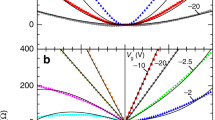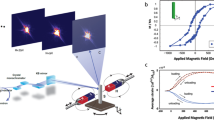Abstract
Inhomogeneity-induced magnetoresistance (IMR) reported in some non-magnetic semiconductors1,2,3,4,5,6,7,8, particularly silicon1,6,7,8, has generated considerable interest owing to the large magnitude of the effect and its linear field dependence (albeit at high magnetic fields). Various theories implicate9,10,11,12,13,14,15,16,17,18 spatial variation of the carrier mobility as being responsible for IMR. Here we show that IMR in lightly doped silicon can be significantly enhanced through hole injection, and then tuned by an applied current to arise at low magnetic fields. In our devices, the ‘inhomogeneity’ is provided by the p–n boundary formed between regions where conduction is dominated by the minority and majority charge carriers (holes and electrons) respectively; application of a magnetic field distorts the current in the boundary region, resulting in large magnetoresistance. Because this is an intrinsically spatial effect, the geometry of the device can be used to enhance IMR further: we designed an IMR device whose room-temperature field sensitivity at low fields was greatly improved, with magnetoresistance reaching 10% at 0.07 T and 100% at 0.2 T, approaching the performance of commercial giant-magnetoresistance devices19,20. The combination of high sensitivity to low magnetic fields and large high-field response should make this device concept attractive to the magnetic-field sensing industry. Moreover, because our device is based on a conventional silicon platform, it should be possible to integrate it with existing silicon devices and so aid the development of silicon-based magnetoelectronics.
This is a preview of subscription content, access via your institution
Access options
Subscribe to this journal
Receive 51 print issues and online access
$199.00 per year
only $3.90 per issue
Buy this article
- Purchase on Springer Link
- Instant access to full article PDF
Prices may be subject to local taxes which are calculated during checkout




Similar content being viewed by others
References
Delmo, M. P., Yamamoto, S., Kaisa, S., Ono, T. & Kobayashi, K. Large positive magnetoresistive effect in silicon induced by the space-charge effect. Nature 457, 1112–1115 (2009)
Solin, S. A., Thio, T., Hines, D. R. & Heremans, J. J. Enhanced room-temperature geometric magnetoresistance in inhomogeneous narrow-gap semiconductors. Science 289, 1530–1532 (2000)
Xu, R. et al. Large magnetoresistance in non-magnetic silver chalcogenides. Nature 390, 57–60 (1997)
Husmann, A. et al. Megagauss sensors. Nature 417, 421–424 (2002)
Hu, J. S. & Rosenbaum, T. F. Classical and quantum routes to linear magnetoresistance. Nature Mater. 7, 697–700 (2008)
Wu, L. H. et al. Room-temperature nonsaturating magnetoresistance of intrinsic bulk silicon in high pulsed magnetic fields. Appl. Phys. Lett. 98, 112113 (2011)
Delmo, M. P., Kaisa, S., Kobayashi, K. & Ono, T. Current-controlled magnetoresistance in silicon in non-Ohmic transport regimes. Appl. Phys. Lett. 95, 132106 (2009)
Schoonus, J. J. H. M., Haazen, P. P. J., Swagten, H. J. M. & Koopmans, B. Unraveling the mechanism of large room-temperature magnetoresistance in silicon. J. Phys. D 42, 185011 (2009)
Parish, M. M. & Littlewood, P. B. Non-saturating magnetoresistance in heavily disorder semiconductors. Nature 426, 162–165 (2003)
Hu, J. S., Parish, M. M. & Rosenbaum, T. F. Nonsaturating magnetoresistance of inhomogeneous conductors: comparison of experiment and simulation. Phys. Rev. B 75, 214203 (2007)
Parish, M. M & Littlewood, P. B. Classical magnetotransport of inhomogeneous conductors. Phys. Rev. B 72, 094417 (2005)
Herring, C. Effects of random inhomogeneities on electrical and galvanomagnetic measurements. J. Appl. Phys. 31, 1939–1953 (1960)
Stroud, D. Generalized effective-medium approach to the conductivity of an inhomogeneous material. Phys. Rev. B 12, 3368–3373 (1975)
Stroud, D. & Pan, F. P. Effect of isolated inhomogeneities on the galvanomagnetic properties of solids. Phys. Rev. B 13, 1434–1438 (1976)
Stroud, D. & Pan, F. P. Magnetoresistance and Hall coefficient of inhomogeneous metals. Phys. Rev. B 20, 455–465 (1979)
Stroud, D. New exact results for the Hall coefficient and magnetoresistance of inhomogeneous two-dimensional metals. Phys. Rev. B 30, 447–449 (1984)
Guttal, V. & Stroud, D. Model for a macroscopically disordered conductor with an exactly linear high-field magnetoresistance. Phys. Rev. B 71, 201304(R) (2005)
Magier, R. & Bergman, D. J. Strong-field magnetotransport of two-phase disordered media in two and three dimensions: Exact and approximate results. Phys. Rev. B 74, 094423 (2006)
Duvail, J. L. et al. Giant magnetoresistance in hybrid nanostructures. J. Magn. Magn. Mater. 151, 324–332 (1995)
Parkin, S. S. P. Giant magnetoresistance in magnetic nanostructures. Annu. Rev. Mater. Sci. 25, 357–388 (1995)
Schoonus, J. J. H. M., Bloom, F. L., Wagemans, W., Swagten, H. J. M. & Koopmans, B. Extremely large magnetoresistance in boron-doped silicon. Phys. Rev. Lett. 100, 127202 (2008)
Baibich, M. N. et al. Giant magnetoresistance in Fe(001)/Cr(001) superlattices. Phys. Rev. Lett. 61, 2472–2475 (1988)
Parkin, S. S. P. et al. Giant tunneling magnetoresistance at room temperature with MgO (100) tunnel barrier. Nature Mater. 3, 862–867 (2004)
Hu, B. & Wu, Y. Tuning magnetoresistance between positive and negative in organic semiconductors. Nature Mater. 6, 985–991 (2007)
Bloom, F. L., Wagemans, W., Kemerink, M. & Koopmans, B. Separating positive and negative magnetoresistance in organic semiconductor devices. Phys. Rev. Lett. 99, 257201 (2007)
Acknowledgements
This work is supported by the Ministry of Science and Technology of China (grant 2009CB929202) and the National Science Foundation of China (grants 11074141 and U0734001). We used the resources of the Beijing National Center for Electron Microscopy.
Author information
Authors and Affiliations
Contributions
C.H.W. designed research blueprints, did the main experimental measurements and the finite element modelling and wrote the manuscript. X.Z.Z. contributed to project design, experimental and theoretical analysis, manuscript writing and whole project supervision. X.L.G. and J.M.W. contributed to the measurements. X.Y.T. contributed to the modelling work. All authors contributed to result analysis and commented on the manuscript.
Corresponding author
Ethics declarations
Competing interests
The authors declare no competing financial interests.
Supplementary information
Supplementary Information
This file contains Supplementary Text and Data 1-7 (see Contents for more details), Supplementary Figures 1-6 with legends and additional references. (PDF 1310 kb)
Rights and permissions
About this article
Cite this article
Wan, C., Zhang, X., Gao, X. et al. Geometrical enhancement of low-field magnetoresistance in silicon. Nature 477, 304–307 (2011). https://doi.org/10.1038/nature10375
Received:
Accepted:
Published:
Issue Date:
DOI: https://doi.org/10.1038/nature10375
This article is cited by
-
Voltage-Controlled Magnetoresistance in Silicon Nanowire Transistors
Scientific Reports (2018)
-
Room temperature magneto-optic effect in silicon light-emitting diodes
Nature Communications (2018)
-
The space charge limited current and huge linear magnetoresistance in silicon
Scientific Reports (2018)
-
Size-dependent magnetic tuning of lateral photovoltaic effect in nonmagnetic Si-based Schottky junctions
Scientific Reports (2017)
-
Imitating the brain with neurocomputer a “new” way towards artificial general intelligence
International Journal of Automation and Computing (2017)
Comments
By submitting a comment you agree to abide by our Terms and Community Guidelines. If you find something abusive or that does not comply with our terms or guidelines please flag it as inappropriate.



